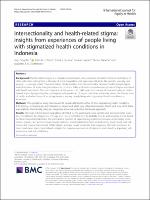Measuring health equity in the ASEAN region: conceptual framework and assessment of data availability
| Barcellona, Capucine
Mariéas, Yzabel Bryanna Tan, Si Ying Lee, Gabriel Ko, Khin Chaw Chham, Savina Leerapan, Borwornsom Pham Tien, Nam Lim, Jeremy |
|
| 2023-12-05 | |
|
Background: Existing research on health equity falls short of identifying a comprehensive set of indicators for measurement across health systems. Health systems in the ASEAN region, in particular, lack a standardised framework to assess health equity. This paper proposes a comprehensive framework to measure health equity in the ASEAN region and highlights current gaps in data availability according to its indicator components. Methods: A comprehensive literature review was undertaken to map out a core set of indicators to evaluate health equity at the health system level. Secondary data collection was subsequently conducted to assess current data availability for ASEAN states in key global health databases, national health accounts, and policy documents. Results: A robust framework to measure health equity was developed comprising 195 indicators across Health System Inputs and Processes, Outputs, Outcomes, and Contextual Factors. Total indicator data availability equated to 72.9% (1423/1950). Across the ASEAN region, the Inputs and Processes sub-component of Health Financing had complete data availability for all indicators (160/160, 100%), while Access to Essential Medicine had the least data available (6/30, 20%). Under Outputs and Outcomes, Coverage of Selected Interventions (161/270, 59.63%) and Population Health (350/350, 100%) respectively had the most data available, while other indicator sub-components had little to none (≤ 38%). 72.145% (384/530) of data is available for all Contextual Factors. Out of the 10 ASEAN countries, the Philippines had the highest data availability overall at 77.44% (151/195), while Brunei Darussalam and Vietnam had the lowest data availability at 67.18% (131/195). Conclusions: The data availability gaps highlighted in this study underscore the need for a standardised framework to guide data collection and benchmarking of health equity in ASEAN. There is a need to prioritise regular data collection for overlooked indicator areas and in countries with low levels of data availability. The application of this indicator framework and resulting data availability analysis could be conducted beyond ASEAN to enable cross-regional benchmarking of health equity. |
|
| Public Health
Health Equity Data availability ASEAN Health systems Global Health Health disparities |
|
| Journal | |
| Text | |
| application/pdf | |
| This work is licensed under a Creative Commons Attribution 4.0 International license (CC BY 4.0). | |
| Open access | |
| Copyright (c) 2023 Barcellona et al. | |
| https://resources.equityinitiative.org/handle/ei/553 |
This item appears in the following Collection(s) |
|
|
Collections
|
Related items
Showing items related by title, author, creator and subject.
-
Human resources for health: task shifting to promote basic health service delivery among internally displaced people in ethnic health program service areas in eastern Burma/Myanmar
Low, Sharon; Tun, Kyaw Thura; Mhote, Naw Pue Pue; Htoo, Saw Nay; Maung, Cynthia; Kyaw, Saw Win; Oo, Saw Eh Kalu Shwe; Pocock, Nicola Suyin (2014-09-29)
Background: Burma/Myanmar was controlled by a military regime for over 50 years. Many basic social and protection services have been neglected, specifically in the ethnic areas. Development in these areas was led by the ethnic non-state actors to ensure care and the availability of health services for the communities living in the border ethnic-controlled areas. Political changes in Burma/Myanmar have been ongoing since the end of 2010. Given the ethnic diversity of Burma/Myanmar, many challenges in ensuring health service coverage among all ... -
Can mHealth and eHealth improve management of diabetes and hypertension in a hard-to-reach population? —lessons learned from a process evaluation of digital health to support a peer educator model in Cambodia using the RE-AIM framework
Steinman, Lesley; Pelt, Maurits van; Hen, Heang; Chhea, Chhorvann; Lan, Channe Suy; Te, Vannarath; LoGerfo, James; Fitzpatrick, Annette L. (2020-10-05)
Background: The burden of non-communicable diseases (NCDs) is increasing in low- and middle-income countries (LMICs) where NCDs cause 4:5 deaths, disproportionately affect poorer populations, and carry a large economic burden. Digital interventions can improve NCD management for these hard-to-reach populations with inadequate health systems and high cell-phone coverage; however, there is limited research on whether digital health is reaching this potential. We conducted a process evaluation to understand challenges and successes from a digital ... -
Intersectionality and health-related stigma: insights from experiences of people living with stigmatized health conditions in Indonesia
Rai, Sarju Sing; Peters, Ruth M. H.; Syurina, Elena V.; Irwanto, Irwanto; Naniche, Denise; Zweekhorst, Marjolein B. M. (International Journal for Equity in Health, 2020-12)
Abstract Background Health-related stigma is a complex phenomenon, the experience of which intersects with those of other adversities arising from a diversity of social inequalities and oppressive identities like gender, sexuality, and poverty – a concept called “intersectionality”. Understanding this intersectionality between health-related stigma and other forms of social marginalization can provide a fuller and more comprehensive picture of stigma associated with health conditions. The main objective ...



